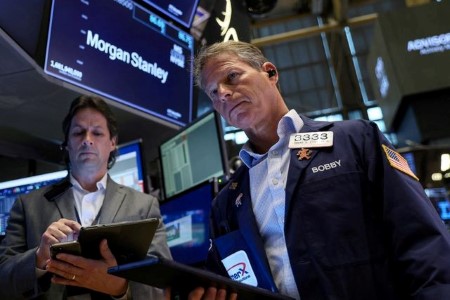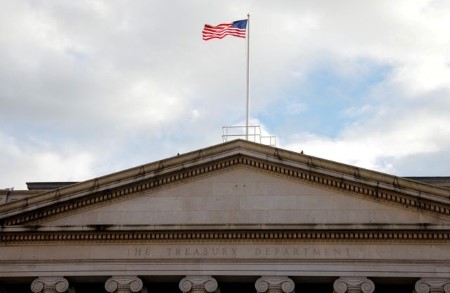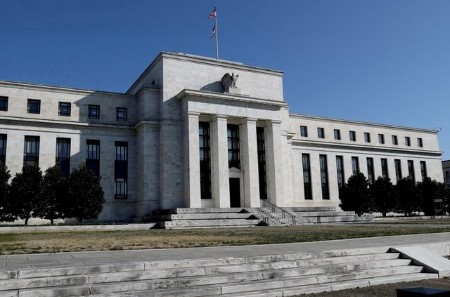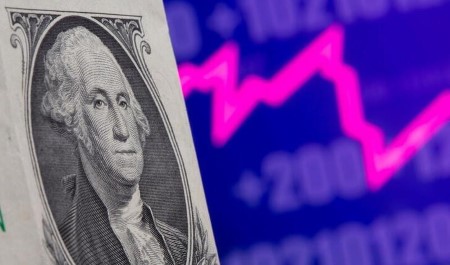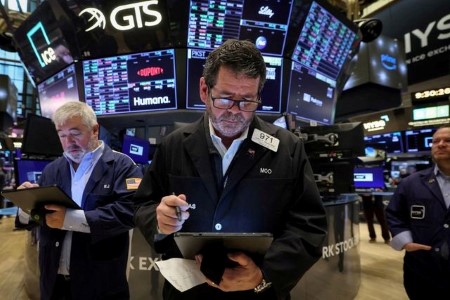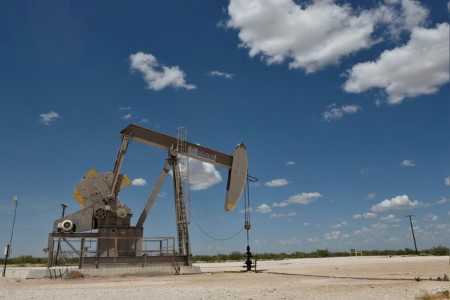NEW YORK, May 1 (Reuters) – Bond investors, fearing a recession is around the corner and preparing for an end of the Federal Reserve’s tightening cycle, have embraced the safety of US Treasuries and shed risky exposures in investment grade and high yield credit.
The collapse in March of Silicon Valley Bank and Signature Bank, and the current turmoil at First Republic Bank (FRC), have further pressured market players to take a defensive stance to protect their portfolios.
The Fed is widely expected to raise interest rates by 25 basis points (bps) at its meeting this week to a range of 5.0%-5.25%. The betting is that it will pause after that and possibly start lowering rates in the fall, although the debt ceiling saga has complicated the thinking on that scenario.
Since last March, the Fed has raised interest rates by 500 bps in one of most aggressive tightening cycles over a similar time span since the late 1970s.
“Tight monetary policy, whose impact has not fully emerged yet but it’s going to over the next six months, combined with tighter lending conditions in the banking system, will result in growth continuing to slow as we move through 2023,” said Chip Hughey, managing director, fixed income, at Truist Advisory Services.
It remains a nerve-wracking environment and fund managers have remained either neutral on their risk stance, stuck to Treasuries and high-quality investment grade corporate bonds, or extended duration, which measures the bond’s sensitivity to interest rate changes, in their portfolios.
Going long duration reflects expectations US yields will fall because the Fed will be forced to cut rates. As the economy slows down, longer duration in fixed income tends to perform well.
That is the opposite though of what tends to happen in a tightening cycle. During the Fed’s aggressive rate-hike phase last year, investors shortened their duration exposure.
Lon Erickson, managing director and portfolio manager at Thornburg Investment Management said any recession and rate cuts “should reverberate throughout the curve into the five-year, 10-year, and 30-year part.”
“You want to have more duration on because that means you will get more bang for your buck for that interest rate move.”
In the credit sector, Thornburg has gravitated toward businesses such as health care and utilities, viewed as resilient in a downturn.
Data showed US government bond funds secured USD 2.22 billion worth of inflows, in the week ended April 26, compared with net selling of USD 2.14 billion in the previous week. Treasury ETFs saw inflows, as well, during the week totaling USD 634 million.
In terms of price action, US 5-year yields dropped 67 bps since March, suggesting increased demand from investors. US 10-year yields likewise showed the same pattern, dropping 47 bps.
Chris Diaz, portfolio manager and co-head of global taxable fixed income at Brown Advisory, said long duration in the firm’s bond portfolio is concentrated in the two- to the seven-year part of the curve, with the firm holding low levels of credit risk.
“We are pretty significant underweight investment grade corporate bonds and no high yield.”
STAYING NEUTRAL
Some investors though have opted to stay “neutral duration” on their strategies, citing outsized moves in Treasuries that saw a big rally, combined with the uncertainty surrounding the debt ceiling.
US Treasuries rallied in March, pushing yields lower, as the market sought safety during the banking crisis. US two-year yields, which reflect rate expectations, fell nearly 60 bps in March, the largest monthly fall since December 2007.
“The market has already raced ahead — you have a 2-year (yield) right now of 4.03% and that is 100 basis points (below) what it was a month ago,” said Todd Thompson, managing director and portfolio co-manager at Reams Asset Management.
“You don’t want to lean against that too much because we have the debt ceiling debate…sometime in the summer.”
The US Senate showed no sign of moving to avoid a looming crisis on Thursday, as Republicans rejected calls to raise the USD 31.4 trillion limit without conditions and Democrats dismissed the idea of talks.
Investors feared that a debt impasse could damage the economy and cause market chaos, forcing the Fed to cut rates earlier than it should.
“There’s so much in flux here and abroad impacting the rate environment,” said Thornburg’s Erickson. “We are going to stick to individual bonds like Treasuries where it makes sense.”
(Reporting by Gertrude Chavez-Dreyfuss; Editing by Alden Bentley)







 DOWNLOAD
DOWNLOAD




